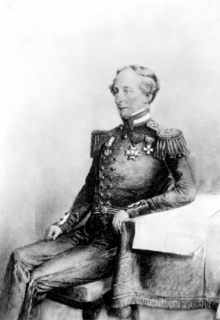Robert Lambert Baynes
Sir Robert Baynes | |
|---|---|
 Rear Admiral Robert Lambert Baynes, 1850s, unknown artist | |
| Born | 1796 |
| Died | 7 September 1869 Upper Norwood, England |
| Allegiance | |
| Service | |
| Rank | Admiral |
| Commands | HMS Andromache HMS Bellerophon Pacific Station |
| Battles / wars | Greek War of Independence Crimean War San Juan Boundary Dispute |
| Awards | Knight Commander of the Order of the Bath |
Admiral Sir Robert Lambert Baynes KCB (1796 – 7 September 1869) was a Royal Navy officer who went on to be Commander-in-Chief, Pacific Station.
Naval career
Baynes joined the Royal Navy in 1810.[1] He was on board the HMS Asia, the British flagship, during the Battle of Navarino in 1827.[2] Promoted to Captain in 1828, he commanded HMS Andromache and then HMS Bellerophon.[1] As a Rear Admiral he was a senior officer in the Baltic Sea during the Crimean War in 1855.[1]
He was appointed Commander-in-Chief, Pacific Station in 1857.[1] Baynes refused to obey orders from the Governor of the Colony of Vancouver Island, James Douglas, to land marines on San Juan Island to engage American soldiers under the command of Brigadier-General William Selby Harney that had occupied the island on 27 July 1859.[2] Accordingly, he is credited with adopting a policy of non-intervention that helped to defuse the San Juan Boundary Dispute of 1859 between Britain and the United States of America.[2]
Baynes Sound in British Columbia is named for him,[3] and the town of Ganges on Saltspring Island and the waters offshore, Ganges Harbour, are named for his flagship, HMS Ganges.[4]: 198
He died at Upper Norwood, and was buried at West Norwood Cemetery.
References
- ^ a b c d William Loney RN
- ^ a b c Biography at the Dictionary of Canadian Biography Online
- ^ Walbran, Captain John T. (1971), British Columbia Place Names, Their Origin and History (Facsimile reprint of 1909 ed.), Vancouver/Toronto: Douglas & McIntyre, p. 37, ISBN 0-88894-143-9
- ^ Walbran, Captain John T. (1971), British Columbia Place Names, Their Origin and History (Facsimile reprint of 1909 ed.), Vancouver/Toronto: Douglas & McIntyre, ISBN 0-88894-143-9
See also
- O'Byrne, William Richard (1849). . . John Murray – via Wikisource.
